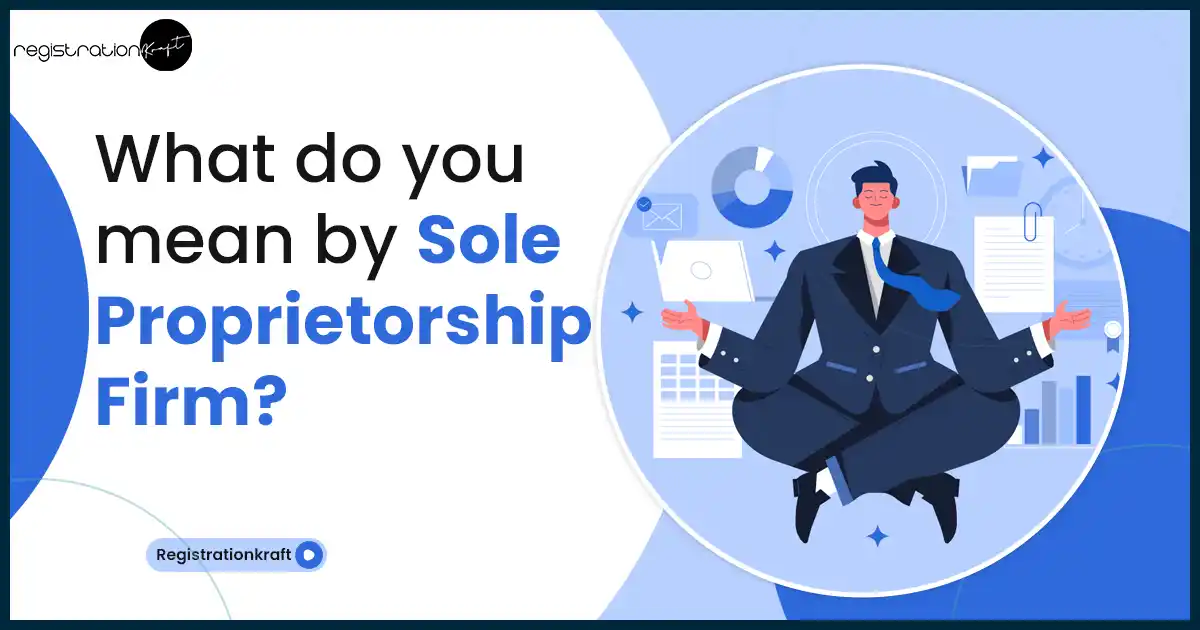Sole Proprietor Business: Meaning, Registration Process, and Tax Rates

Starting your own business might sound like a big leap, but with a sole proprietorship, it’s simpler than you think. This is one of the oldest and easiest business models in India. Here, the business and its owner—known as the “proprietor”—are seen as one entity. Imagine it as a one-person show where you call all the shots.
Setting up a sole proprietorship is quick and straightforward, often taking just 10-15 days. It’s a great choice for anyone looking to start small with minimal investment. Whether you’re running your business from home or renting a space, the capital requirements are low, making it perfect for those who want to dip their toes into entrepreneurship without a hefty financial commitment.
Why Choose a Sole Proprietorship?
As the sole proprietor, you have complete control over your business. Every decision, big or small, is yours to make. What’s more, you get to enjoy all the profits. However, keep in mind that this also means bearing any losses alone—unlike in a partnership or an LLP (Limited Liability Partnership), where the risk is shared.
This setup is ideal for local businesses like spas, hair salons, bakeries, or grocery stores. It’s also a great fit for small traders and manufacturers who want to keep things simple and manageable.
What About Hiring Help?
While the ownership stays entirely with you, you can still hire people to help run your business. Think of it as building a small team that works under your guidance while you remain in full control.
Is Sole Proprietor Business Right for You?
If you’re someone who prefers flexibility, independence, and starting small, a sole proprietorship might be the perfect fit. It’s a fantastic way to bring your business ideas to life without jumping into the complexities of bigger business models.
So, whether you dream of opening a cozy bakery, a stylish hair salon, or a friendly neighborhood grocery store, a sole proprietorship can be your stepping stone to success. Ready to take that first step? Your journey as an entrepreneur starts here!
How to Register a Sole Proprietor Business in India: A Simple Guide
Starting your own business as a sole proprietor is one of the easiest ways to step into the world of entrepreneurship in India. Unlike other business structures, a sole proprietorship doesn’t require formal incorporation. Once you’ve completed a few simple steps and met the basic requirements, you’re ready to get started! Let’s break down the process to make it easier for you to follow.
1. Gather Your Documents
Think of this as the foundation for your business. Start by collecting the required documents:
- KYC Documents: Your PAN card and Aadhaar card.
- Address Proof: This could be a utility bill, rental agreement, or other official proof of your business location.
Make sure all the information is accurate and up to date. It’s better to double-check now than face issues later!
2. Pick a Unique Name for Your Business
Your business name is your identity, so choose wisely! Here are some tips:
- The name should be original and not already in use by another registered business.
- It must comply with legal requirements—avoid anything offensive or insensitive.
- Consider registering your business name as a trademark. This ensures no one else can copy or misuse it in the future.
A good name isn’t just about legality—it’s also your first impression on customers!
3. Get MSME/Udyam Registration (Optional but Useful)
If you’re running a small business, registering as an MSME (Micro, Small, and Medium Enterprise) or under Udyam can bring significant benefits:
- Access to collateral-free loans.
- Lower fees for trademark registration.
- Interest subsidies on loans.
- Priority in getting payments from buyers.
Plus, having this udyam registration certificate makes it easier to open a business bank account, a crucial step for managing your finances.
4. Register for GST (If Applicable)
You’ll need to register for GST if your annual turnover exceeds:
- ₹40 lakhs (for goods).
- ₹20 lakhs (for services).
- ₹10 lakhs (if you’re in a northeastern state).
In some cases, GST registration is mandatory regardless of turnover. Submitting your application on the GST portal is straightforward. Once approved, you’ll receive a GSTIN (Goods and Services Tax Identification Number)—your key to handling all GST-related activities.
5. Comply with the Shops & Establishments Act
If your business has a physical location, you’ll likely need to register under the Shops & Establishments Act. This registration helps ensure your business complies with local labor laws. Simply submit your application and required documents to the Labor Department of your state—most states offer online and offline options.
6. Check for Industry-Specific Licenses
Depending on your business type and location, additional licenses may be required. For example:
- FSSAI License: For businesses dealing with food.
- APEDA License: For exporting agricultural or food products.
Make sure you research the specific licenses your business might need. It’s better to get everything sorted upfront rather than face legal hurdles later.
Sole Proprietorship Tax Rate
The tax rate for a sole proprietorship firm is the same as the individual business rate. You can check the tax rates in the tables listed below:
Tax Rate according to the New Tax Regime & Old Tax Regime
In the table below, the tax rates based on income range have been mentioned as per the old and new regime.
| Income Range (in Rs.) | Tax Rate as per the New Regime | Tax Rate as per the Old Regime |
| Rs. 0 – 2,50,000 | Not Applicable (N.A.) | Not Applicable (N.A.) |
| Rs. 2,50,001 – 5,00,000 | 5% | 5% |
| Rs. 5,00,001 – 7,50,000 | 10% | 20% |
| Rs. 7,50,001 – 10,00,000 | 15% | 20% |
| Rs. 10,00,001 – 12,50,000 | 20% | 30% |
| Rs. 12,50,001 – 15,00,000 | 25% | 30% |
| More than Rs. 15,00,000 | 30% | 30% |
Tax Rate if the Owner/Proprietor is a Senior Citizen
The following table shows the tax rate for the sole proprietorship if the owner or proprietor is more than 60 and younger than 80:
| Income Tax Slab (in Rs.) | Income Tax Rate |
| Up to Rs. 3,00,000 | Not Applicable (N.A.) |
| Rs. 3,00,000 – 5,00,000 | 5% of the total income above Rs. 3,00,000 |
| Rs. 5,00,000 – 10,00,000 | Rs. 10,000 + 20% of the total income above Rs. 5,00,000 |
| More than Rs. 10,00,000 | Rs. 1,10,000 + 30% of the total pay above Rs. 10,00,000 |
Tax Rate if the Owner/Proprietor is a Super Senior Citizen
The following table shows the tax rate for the sole proprietorship if the owner or proprietor is over 80:
| Income Tax Slab (in Rs.) | Income Tax Rate |
| Up to Rs. 5,00,000 | Not Applicable (N.A.) |
| Rs. 5,00,000 to 10,00,000 | 20% of the total income above Rs. 5,00,000 |
| More than Rs. 10,00,000 | Rs. 1,00,000 + 30% of total income above Rs. 10,00,000 |
Tax Rate if the Owner/Proprietor is an NRI
The following table shows the tax rate for the sole proprietorship if the owner or proprietor is a non-resident individual (NRI). The tax rate is for all the NRIs, irrespective of their age.
| Income Tax Slab (in Rs.) | Income Tax Rate |
| Up to Rs. 2,50,000 | Not Applicable (N.A.) |
| Rs. 2,50,000 – Rs. 5,00,000 | 5% of the total income above Rs. 2,50,000 |
| Rs. 5,00,000 – 10,00,000 | Rs. 12,500 + 20% of total income above 5,00,000 |
| More than Rs. 10,00,000 | Rs. 1,12,500 + 30% of the total income above Rs. 10,00,000 |
Surcharge
A surcharge is applicable in the following cases:
- A surcharge of 10% of the income tax is applicable if the total income is between Rs. 50 Lakh to Rs. 1 Crore.
- A surcharge of 15% of the income tax is applicable if the total income is between Rs. 1 Crore to Rs. 2 Crore.
- A surcharge of 25% of the income tax is applicable if the total income is between Rs. 2 Crore to Rs. 5 Crore.
- If the total income is above Rs. 5 Crore, a surcharge of 37% (under old regime) and 25% (under new regime) of the income tax is applicable.
- As per the provisions of Sections 111A, 112A and 115AD, the maximum rate of surcharge on income from dividends or income is 15%.
- 4% of the income tax has to be paid in the form of Health and Education Cess by all taxpayers regardless of the income tax slab they fall under.
Conclusion
Starting a sole proprietorship is simple, but it’s essential to get all your registrations and licenses in place. These steps aren’t just about compliance—they build trust with your customers and give your business a solid foundation to grow.
Remember, every great business starts with a single step. Follow this guide, and you’ll be on your way to running a successful sole proprietorship in no time!
Categories: Business
Tags: Business, Business Registration, Company Registration, Startup





